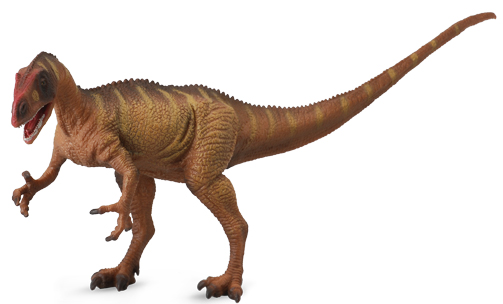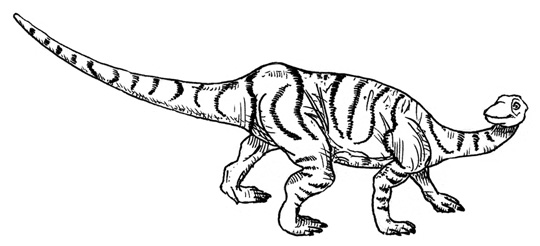The Lost Kingdom of the Purbeck Group
The Lost Kingdom of The Purbeck Group
Our thanks to Thomas for sending into us the third and final article that he has compiled over the summer holidays. Thomas has chosen to feature the biota associated with the Lower Cretaceous deposits of the Purbeck Group of south-eastern England.
The Purbeck Group
The Purbeck Group consists of limestone, mudstones and evaporites representing a series of freshwater, brackish and marine environments laid down in the Upper Jurassic and into the Lower Cretaceous, approximately 145 to 139 million years ago. The fossils associated with these sedimentary rocks provide evidence of changing palaeoenvironments and also of faunal turnover, including a record of different types of dinosaur.
This world is not talked about often but is very interesting for at some point during the Late Jurassic allosauroids became extinct in the British Isles only to return sometime in the Early Cretaceous (around 140-139 million years ago). Falling sea levels are thought to have contributed to the reintroduction of these theropods to their former territory. During their absence, tyrannosauroids evolved to fill the niche left by the allosauroids, although in the Jurassic, they were not apex predators.
Let’s Meet the Dinosaur Fauna of this Lost Kingdom
- Nuthetes destructor – known from extremely fragmentary fossil material, possibly a dromaeosaurid or perhaps a member of the Tyrannosauroidea (Proceratosauridae?). The size of this dinosaur is unknown, although based on measurements of the anterior portion of the partial dentary associated with this species, a length of approximately 1.6 metres has been speculated.
- Echinodon becklesii – represented by isolated teeth, one fragmentary skull and a handful of isolated jaw bones, this dinosaur is thought to be a member of the Heterodontosauridae. It was a relatively small dinosaur with a body length of approximately 60 centimetres.
- Owenodon hoggii – regarded as an ornithopod and known from a badly crushed right dentary found at Durleston Bay (Dorset) in 1860. Hind limb material from near Speeton, (Yorkshire), recovered from Berriasian-aged deposits and a single tooth from Spain have also been tentatively assigned to O. hoggii. The size of Owenodon remains unknown but it has been suggested that it could have been around 6 metres long. Its taxonomic position remains uncertain. When first described in the mid 1870s it was thought the fossils represented a type of Iguanodon.
A Life Reconstruction of the Ornithopod Owenodon hoggii
Picture credit: Everything Dinosaur
Undiagnostic Dinosaur Specimens
The Purbeck Limestone Group has also yielded a variety of other dinosaur fossils. For example, a single, beautifully preserved tooth and a partial tail bone (caudal vertebra), which represent an armoured dinosaur. These fossils lack any specific autapomorphies (distinct features or traits), they are regarded as indeterminate, although it could be speculated that these fragmentary fossils represent a member of the Nodosauridae family, possibly a member of the subfamily Polacanthinae. A single, partial metacarpal from a sauropod has also been found.
Numerous trace fossils consisting of dinosaur tracks have been identified. Footprint fossils suggest the presence of other types of dinosaurs such as small ornithopods within the Purbeck Group ecosystem, there is even a track-way which may have conceivably been left by the “Purbeck giant tyrannosauroid”.
The Purbeck Giant Tyrannosauroid
Dinosaur tracks (natural casts), along with a single metatarsal bone indicate the presence of large theropods. Classifying this material has proved difficult. It has been suggested that these trace fossils and the body fossil (single foot bone), could represent a member of the Tyrannosauroidea. This theropod superfamily is now known to have been both geographically and temporally wild spread during the Late Jurassic and the Early Cretaceous.
Evidence linking this fossil to the Maniraptora is limited. Based on comparative studies of other theropod toe bones, it has been estimated that the “Purbeck giant” could have been around 6.7 metres long with a hip height of approximately 1.9 metres. To put into perspective why the “Purbeck giant” can’t be a maniraptoran, comparative analysis based on the foot bones of members of the Maniraptora suggest that this toe bone represents a maniraptoran that would have measured in excess of 9 metres in length.
The fossil bone (metatarsal III), could have come from a tyrannosauroid. Until the arrival of the carcharodontosaurids in this part of western Europe, the “Purbeck giant” was most likely the apex predator. This specimen was collected from Durlston Bay on the Isle of Purbeck (Lulworth Formation subdivision of the Purbeck Group).
When allosauroids (carcharodontosaurids), recolonised what was to become the southern British Isles, there may have been a faunal turnover event with the carcharodontosaurids replacing members of the Tyrannosauroidea as apex and secondary predators. The youngest strata associated with the Purbeck Group (the Durlston Formation), partly overlaps with the Ashdown Formation of the Wealden Group (both Berriasian in age). The dinosaur fossils associated with the Ashdown Formation and the younger elements that between them form the Hastings Subgroup, represent a different dinosaur fauna than what is associated with the Purbeck Group.
Neovenator salerii – Known from the Isle of Wight (Barremian Stage)

The picture (above) shows a model from the CollectA Deluxe range.
To view this range of prehistoric animal models: CollectA Deluxe Prehistoric Life.
The Late Jurassic Climate
The climate at the time would have been like the Late Jurassic and it gradually became more temperate. The fossil forest ledges, preserved east of Lulworth Cove, represent an interesting and integral part of this ecosystem. Imagine a coastal conifer forest, now cover the floor of it in mosses and algae and dried up seaweed. The ingress of the tides permitted bacterial colonies to form large doughnut-shaped concretions around many tree stumps, these structures, termed thromobolites, can be observed today. Some of these circular structures are big enough for a person to sit in.
Fossils of Mammals Associated with the Purbeck Group
The sedimentary rocks associated with the Purbeck Group has also yielded fossils of many other types of vertebrate including fragmentary jaws and teeth of several types of Early Cretaceous mammal: Early Placental Mammals Identified. It is likely that pterosaurs were present, the fossil record of flying reptiles is particularly poor, but tracks preserved in sediments that represent intertidal flats have been ascribed to the ichnogenus Purbeckopus pentadactylus and these tracks suggest the presence of large pterosaurs.
The speed in which the carcharodontosaurids outcompeted tyrannosauroids, like the “Purbeck giant”, might lead to the conclusion that carcharodontosaurids were more successful, efficient and effective predators than either the Pantyrannosauria, a recently proposed clade consisting of all those theropods related to T. rex and Dilong paradoxus but not including Proceratosaurus bradleyi and the Proceratosauridae. Owenodon was a bit like a blend between Camptosaurus and Mantellisaurus – fast but still of decent size. Nuthetes would have mainly hunted the mammals, reptiles, baby dinosaurs and Echinodon.
Our thanks to Thomas for sending in the information which helped us to compile this article.
To read an article published in 2018, which provides information on the discovery of sauropod tracks on the Isle of Purbeck: Dorset Dinosaur Tracks Discovered.
Visit the Everything Dinosaur website: The Everything Dinosaur Website.


